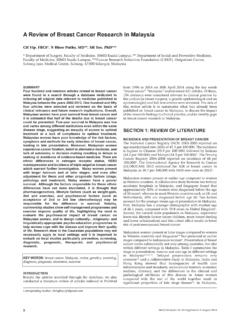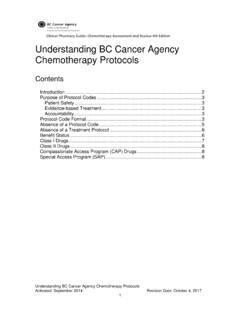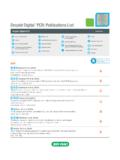Transcription of American Society of Clinical Oncology Guideline ...
1 American Society of Clinical Oncology GuidelineRecommendations for sentinel Lymph Node Biopsy inEarly-Stage breast CancerGary H. Lyman, Armando E. Giuliano, Mark R. Somerfield, Al B. Benson III, Diane C. Bodurka,Harold J. Burstein, Alistair J. Cochran, Hiram S. Cody III, Stephen B. Edge, Sharon Galper,James A. Hayman, Theodore Y. Kim, Cheryl L. Perkins, Donald A. Podoloff,Visa Haran Sivasubramaniam, Roderick R. Turner, Richard Wahl, Donald L. Weaver, Antonio C. Wolff,and Eric P. WinerABSTRACTP urposeTo develop a Guideline for the use of sentinel node biopsy (SNB) in early stage breast American Society of Clinical Oncology (ASCO) Expert Panel conducted a systematicreview of the literature available through February 2004 on the use of SNB in early-stagebreast cancer . The panel developed a Guideline for clinicians and patients regarding theappropriate use of a sentinel lymph node identification and sampling procedure from hereonreferred to as SNB.
2 The Guideline was reviewed by selected experts in the field and theASCO Health Services Committee and was approved by the ASCO Board of literature review identified one published prospective randomized controlled trial in whichSNB was compared with axillary lymph node dissection (ALND), four limited meta-analyses, and69 published single-institution and multicenter trials in which the test performance of SNB wasevaluated with respect to the results of ALND (completion axillary dissection). There are currentlyno data on the effect of SLN biopsy on long-term survival of patients with breast , a review of the available evidence demonstrates that, when performed by experi-enced clinicians, SNB appears to be a safe and acceptably accurate method for identifyingearly-stage breast cancer without involvement of the axillary lymph is an appropriate initial alternative to routine staging ALND for patients with early-stagebreast cancer with clinically negative axillary nodes.
3 Completion ALND remains standardtreatment for patients with axillary metastases identified on SNB. Appropriately identifiedpatients with negative results of SNB, when done under the direction of an experiencedsurgeon, need not have completion ALND. Isolated cancer cells detected by pathologicexamination of the SLN with use of specialized techniques are currently of unknown clinicalsignificance. Although such specialized techniques are often used, they are not a requiredpart of SLN evaluation for breast cancer at this time. Data suggest that SNB is associatedwith less morbidity than ALND, but the comparative effects of these two approaches ontumor recurrence or patient survival are Clin Oncol 23:7703-7720. 2005 by American Society of Clinical OncologyINTRODUCTIONThe disease status of the axillary lymphnodes is the most significant prognostic fac-tor for patients with early-stage breast can-cer.
4 Predictors of node metastases includetumor size, lymphovascular invasion, tumorgrade, and patient age. Receptor status,From the University of RochesterSchool of Medicine and Dentistry,Rochester, NY; John Wayne CancerInstitute, Santa Monica, CA; Northwest-ern University, Evanston, IL; TheUniversity of Texas AndersonCancer Center, Houston, TX; Dana-Farber cancer Institute, Boston, MA;David Geffen School of Medicine,University of California, Los Angeles,Los Angeles, CA; Memorial Sloan-Kettering cancer Center, New York,NY; Roswell Park cancer Institute,Buffalo, NY; Brigham and Women sHospital, Boston, MA; University ofMichigan, Ann Arbor, MI; Tufts-NewEngland Medical Center, Boston, MA;the Susan G. Komen breast CancerFoundation, Dallas, TX; The Universityof Texas Anderson CancerCenter, Houston, TX; University ofKentucky, Lexington, KY; St John sHealth Center, Santa Monica, CA; TheJohns Hopkins University, Baltimore,MD; University of Vermont College ofMedicine, Burlington, VT; Dana-FarberCancer Institute, Boston, MA; SidneyKimmel Comprehensive cancer Centerat Johns Hopkins, Baltimore, August 3, 2005; acceptedAugust 4, disclosures of potential con-flicts of interest are found at the end ofthis reprint requests to AmericanSociety of Clinical Oncology , CancerPolicy and Clinical Affairs, 1900 DukeSt, Suite 200, Alexandria, VA 22314.
5 E-mail: 2005 by American Society of ClinicalOncology0732-183X/05/2330-7703/$ : OFCLINICALONCOLOGYASCO SPECIAL ARTICLEVOLUME 23 NUMBER 30 OCTOBER 20 20057703 Downloaded from on May 20, 2011. For personal use only. No other uses without 2005 American Society of Clinical Oncology . All rights content (ploidy), tumor location, method of detec-tion, and presence of casting-type calcifications on mam-mography have some predictive , nocombination of predictors of axillary node status has re-placed surgical resection and histopathologic examinationof the lymph use of mammography and in-creased public awareness of breast cancer have resulted inwomen having smaller tumors at the time of initial presen-tation, a lower risk of involved nodes, and fewer ,9 Similarly, whileadvances in computed tomogra-phy (CT), magnetic resonance imaging (MRI), positronemission tomography (PET)
6 , and ultrasonography canoften identify suspiciousnodes in the axilla, false-negativefindings and failure to detect small metastases are , reliance on histologic examination of removed lymphnodes at the time of axillary lymph node dissection (ALND)is thought to be the most accurate method for assessingspread of disease to the lymph nodes. Accurate assessmentof the nodes is important not only for staging and progno-sis, but also for guiding treatment , the anatomic disruption caused by ALNDmay also result in lymphedema, nerve injury, shoulder dys-function, and other complications that may compromisefunctionality and quality of life. Systematic studies in breastcancer have shown that breast cancer spreads to one or a fewlymph nodes, the sentinel lymph node(s) (SLNs), before itspreads to other axillary nodes and that these SLNs can beidentified by using vital blue dye, a radiolabeled colloid, ,11 The findings of these early studies suggested thatthe use of a sentinel lymph node identification and sam-pling procedure referred to here as sentinel node biopsy(SNB) could be reliably performed in selected patients withearly stage breast cancer by a carefully trained multidisci-plinary team (surgeon, pathologist, nuclear medicine tech-nician)
7 , thus reducing the need for ALND and avoiding theassociated few controlled clinicalstudies of SNB, this procedure has become widely practicedin the United States, Europe, and Australia. Currently, atmost major cancer centers in the United States, SNB isperformed without ALND if no disease is found in American Society of Clinical Oncology (ASCO)convened an Expert Panel to develop recommendations forthe use of SNB in Oncology practice and to determine itssuitability in the staging and management of early stagebreast QUESTIONSThis Guideline addresses four principal questions regardingthe appropriateness of SNB for the management of earlystage breast cancer :1. How should the results of SNB be utilized in clinicalpractice?a. Can full ALND be avoided in patients who havenegative findings on SNB?
8 B. Is full ALND necessary for all patients with positivefindings on SNB?2. What is the role of SNB in special circumstances inclinical practice? (These special circumstances include largeand locally advanced invasive tumors, multicentric tumors,inflammatory breast cancer , ductal carcinoma-in-situ [DCIS],older age [65 years or more], obesity, male breast cancer ,pregnancy, evaluation of the internal mammary nodes, pres-ence of suspicious palpable axillary nodes, prior breast or axil-lary surgery, and preoperative systemic therapy.)3. What factors affect the success of SNB (including lowrates of complications and false-negative results)?4. What are the potential benefits and harms associatedwith SNB?PRACTICE GUIDELINESP racticeguidelines are systematically developed statements toassist practitioners and patients in making decisions aboutappropriate health care for specific Clinical circumstances.
9 At-tributes of good guidelines include validity, reliability, repro-ducibility, Clinical applicability, Clinical flexibility, clarity,multidisciplinary process, review of evidence, and documen-tation. guidelines may be useful in producing better care anddecreasing cost. Specifically, utilization of Clinical guidelinesmay provide the following:1. Improvement in outcomes2. Improvement in medical practice3. Means for minimizing inappropriate practice variation4. Decision support tools for practitioners5. Points of reference for medical orientation andeducation6. Criteria for self-evaluation7. Indicators and criteria for external quality review8. Assistance with reimbursement and coveragedecisions9. Criteria for use in credentialing decisions10. Identification of areas where further research isneededIn formulating recommendations for the appropriateuse of the SNB in the management of early stage breastcancer, ASCO considered these tenets of Guideline develop-ment, emphasizing review of data from appropriately con-ducted and analyzed Clinical trials.
10 However, it is importantto note that guidelines cannot always account for individualvariation among patients. guidelines are not intended tosupplant physician judgment with respect to particular pa-tients or special Clinical situations and cannot be consideredinclusive of all proper methods of care or exclusive of othertreatments reasonably directed at obtaining the same et al7704 JOURNAL OFCLINICALONCOLOGYD ownloaded from on May 20, 2011. For personal use only. No other uses without 2005 American Society of Clinical Oncology . All rights , ASCO considers adherence to these guide-lines to be voluntary, with the ultimate determination regard-ing their application to be made by the physician in light ofeach patient s individual circumstances. In addition, theseguidelines describe the use of procedures and therapies inclinical practice; they cannot be assumed to apply to the use ofthese interventions performed in the context of Clinical trials,given that Clinical studies are designed to evaluate or validateinnovative approaches in a disease for which improved stagingand treatment is needed.



